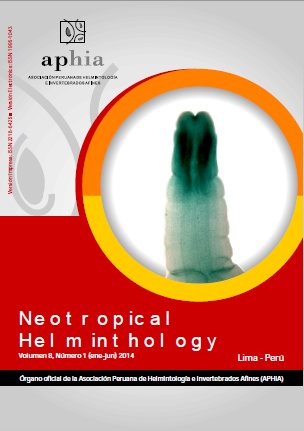ENDOPARASITE COMMUNITY STRUCTURE OF THREE FISH SPECIES IN TRIBUTARY STREAMS OF THE RIVER PIRAPÓ, PARANÁ STATE, BRAZIL
DOI:
https://doi.org/10.24039/rnh201481903Keywords:
Cucullanus (Cucullanus) pinnai, Pirapó river, Poecilia reticulata, Rhamdia quelen, Sebekia oxycephala.Abstract
An ichthyoparasitological study on 166 fishes, belonging to Poecilia reticulata Peters, 1859 (Poeciliidae), Rhamdia quelen (Quoy & Gaimard, 1824) (Pimelodidae) and Hypostomus ancistroides (Ihering, 1911) (Loricariidae) in tributary streams of the Pirapó River, located in and around urban city of Maringá, Paraná State, Brazil. The research aimed to recognize the endoparasite community of fishes analyzed, as well as to improve the knowledge about host/parasite relationships. We analyzed the correlation between the total length of the fish with levels of parasitism (prevalence, abundance). Due to the existence of sexual dimorphism in the species P. reticulata, we investigated the possible influence of sex of this fish on parasitism. In addition, we also analyzed the body surface and nostril for ectoparasites studies. There were no metazoan parasites on the body surface and nostril of the species analyzed. Only 15.06% of endoparasite prevalence was observed. A pentastomid species, Sebekia oxycephala (Diesing) Sambon, 1922 and cestode belonging to the order Pseudophyllidea were found, with a prevalence of 13.89 and 0.92%, respectively. The nematode species, Cucullanus (Cucullanus) pinnai Travassos, Artigas and Pereira, 1928 had a prevalence of 39.13% in Rhamdia quelen. No parasites found in the in the fish H. ancistroides. There was no correlation between the sex of P. reticulata with the prevalence and abundance of S. oxycephala. The hosts' lengths were not correlated with the prevalence and abundance of endoparasites. Thus, because parasites found were generalists, there appeared to be no relationship between parasitism with features/peculiarities of analyzed hosts (fishes), as would have been expected with high specificity parasites.
Downloads
Published
How to Cite
Issue
Section
License
Copyright (c) 2021 Neotropical Helminthology

This work is licensed under a Creative Commons Attribution-NonCommercial-NoDerivatives 4.0 International License.
OBJETO: El AUTOR-CEDENTE transfiere de manera TOTAL Y SIN LIMITACIÓN alguna al CESIONARIO los derechos patrimoniales que le corresponden sobre la (s) obra(s) tituladas: xxxxxxxxxxxxxxxx, por el tiempo que establezca la ley internacional. En virtud de lo anterior, se entiende que el CESIONARIO adquiere el derecho de reproducción en todas sus modalidades, incluso para inclusión audiovisual; el derecho de transformación o adaptación, comunicación pública, traducción, distribución y, en general, cualquier tipo de explotación que de las obras se pueda realizar por cualquier medio conocido o por conocer en el territorio nacional o internacional.
REMUNERACIÓN: La cesión de los derechos patrimoniales de autor que mediante este contrato se hace será a título gratuito.
CONDICIONES Y LEGITIMIDAD DE LOS DERECHOS: El AUTOR-CEDENTE garantiza que es propietario integral de los derechos de explotación de la(s) obra(s) y en consecuencia garantiza que puede contratar y transferir los derechos aquí cedidos sin ningún tipo de limitación por no tener ningún tipo de gravamen, limitación o disposición. En todo caso, responderá por cualquier reclamo que en materia de derecho de autor se pueda presentar, exonerando de cualquier responsabilidad al CESIONARIO.
LICENCIA DE ACCESO ABIERTO: El AUTOR-CEDENTE autoriza que manuscrito publicado en La Revista Neotropical Helminthology permanece disponible para su consulta pública en el sitio web https://www.neotropicalhelminthology.com/ y en los diferentes sistemas de indexación y bases de datos en las que la revista tiene visibilidad, bajo la licencia Creative Commons, en la modalidad Reconocimiento-No comercial- Sin Trabajos derivados –aprobada en Perú, y por lo tanto son de acceso abierto. De ahí que los autores dan, sin derecho a retribución económica, a la Asociación Peruana de Helmintología e Invertebrados Afines (APHIA), los derechos de autor para la edición y reproducción a través de diferentes medios de difusión.


 Numero 2 Volumen 19 - 2025 (versión Anticipada)
Numero 2 Volumen 19 - 2025 (versión Anticipada)














































